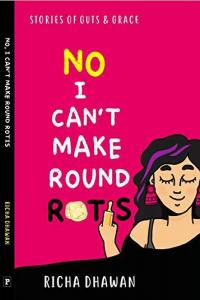Creation and Criticism
ISSN: 2455-9687
(A Quarterly International Peer-reviewed Refereed e-Journal
Devoted to English Language and Literature)
Vol. 06, Joint Issue 22 & 23: July-Oct 2021

Book Review
No, I Can’t Make Round Rotis by Richa Dhawan
Richa Dhawan. No, I Can’t Make Round Rotis. New Delhi: Prestige Books, 2020. Pp. 182. Price : Rs. 200/- (Paperback). ASIN: B08NFHBFX5
Reviewed by Jagdish Batra
Based in Singapore, Richa Dhawan is trained as a doctor but her debut collection of stories No, I Can’t Make Round Rotis projects her as a story-teller of substance. The compilation is a masterly treatment of human feelings, strengths and weaknesses, particularly of women and these appeal straight to the heart as also to the mind. Like Bernard Shaw, Dhawan believes in the dictum “Art for the sake of Life,” and so each one of the thirteen stories hits out at a malady – a psychological conditioning of an individual or a social problem, which she probes expertly.
The opening story “Nimbu Pani” compares the married lives of two diasporic Indian women in Australia. While Nitya, who married her boyfriend, had an ego clash with her husband and like Maya of Cry, the Peacock, pushed her husband to his end, Reena has a helpful and accommodating husband. Moral of the story: Marriage demands adjustment and ego is a big hurdle! Dhawan’s psychological foray into the mind of her characters coupled with powerful narration wins ready empathy of the reader.
A poignant story is “The Tale of Two Sisters” which underlines the importance of euthanasia. Sibling rivalry marked the lives of Ananya and Ridhi from an early age as it was propelled by the parents. The competition took its toll on younger Ananya as she got pregnant at the age of sixteen. Dr. Ridhi came to her rescue and friendship replaced competition. Later, the doctor herself becomes quadriplegic after a stabbing incident, and Ananya comes to her rescue. How? It’s a painful duty that she feels called upon to perform to relieve her sister of excruciating pain.
The current craze for social media and the role of the manipulators or the influencers who jack up responses like ‘likes’ and viewership count are taken up in the story ‘Follow me on Instagram.’ Maya is fed up with life and wishes to end it but the craze for narcissism that the social media fuels comes to her rescue and she becomes a celebrity. Surprisingly, the same addiction to social media by one of her followers becomes the cause of death of her mother! It must be said to Dhawan’s credit that her imaginative craftswomanship in infusing a story with surprising twists and turns makes the book a page-turner.
The ongoing Corona pandemic also forms the background of a story “The End of Carpe Diem.” It is an epistle to children – a kind of time capsule that would be read in future. The story seems a bit autobiographical and has an added flavor of subjective viewpoint. The story “Those kinds of girls” focusses on the misplaced stress on the traditional concept of a good girl who must be devoted to husband even though he is cheating on her and even going about molesting girls. There are stories dealing with superstitions, homosexuals, wife-bashing, fat-shaming, divorcees, gossiping, pollution, colour prejudice, etc.
The stories are admirably spun in a racy narrative. While many stories have a conventional opening, there are others that use the first person narrative and different registers. Besides Dhawan capitalizes on the current craze for magic realism also in the story ‘Superwoman’ which shows the protagonist is able to halt the movement of time, while she alleviates the sufferings of a damsel in distress or teach a lesson to a blackmailer. Not convincing? Sure, but the point is taken, for she was Nirbhaya in her previous life! Interesting variation.
The language is a delightful mix of colloquial and literary depending on what the situation demands. Some of the witty lines which stick to memory are: “a compromised cup of non-gourmet, made out-of-a-pod expresso”, “when she is eating a bar of chocolate- sharing is not caring”, “keep following the pop-culture …to keep up with the Kardashians”, “she had found the one guy, but not the one lehenga to get married,” and so on.
References from contemporary resources like Harari (“Gossiping proves that Homo Sapients are primarily social animals”) or the maxim “Seize the Day” from the famous movie Dead Poets Society are well contextualized in the stories. However, in her enthusiasm, the writer compares the malady to some literary characters which seem rather odd: “Call it Claudius of Hamlet or Iago of Othello or the Jafar of Alladdin, or the demon Mephistopheles or the supervillain Joker; Coronavirus makes them all look trivial.” Dhawan is gifted with lofty imagination and has great future as a story-teller; only she must shun the temptation of “telling it all” instead of “showing” it!
About the Reviewer:
 Dr. Jagdish Batra is serving as Professor of English at O.P. Jindal Global University, Sonepat, Haryana. A Rotary International scholar to USA, he has also published more than 60 research papers in leading research journals, and nine books. He may be contacted at drjagdishbatra@gmail.com.
Dr. Jagdish Batra is serving as Professor of English at O.P. Jindal Global University, Sonepat, Haryana. A Rotary International scholar to USA, he has also published more than 60 research papers in leading research journals, and nine books. He may be contacted at drjagdishbatra@gmail.com.


